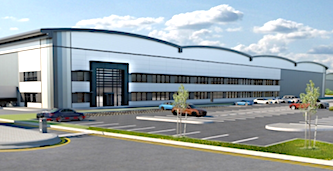The logistics sector in the Northern Powerhouse region has the potential to create 174,000 additional jobs by 2050 “if key barriers are addressed” according to research by logistics developer Tritax Symmetry and planning and development consultancy Turley.
The research looked at numerous reports including the Northern Powerhouse Independent Economic Review which identified the potential growth of the logistics sector under a “transformational growth” scenario.
Under this scenario, the sector is identified as having the potential to achieve growth of 174,000 jobs and £29.6 billion Gross Value Added (GVA) between 2015 and 2050.
“Split evenly by year, this equates to an average of 4,970 jobs and £845 million GVA growth per annum, resulting in an estimated annual salary increase of £5.3bn and a total additional 29,190 professional positions,” said Tritax Symmetry.
Areas identified as needing “substantial improvement” to achieve the region’s growth potential include: supply of sites and premises, infrastructure investment and development, closing the North’s skills gap and delivering planning policy reform.
The report said Gross Value Added (GVA) of the logistics sector in the North of England is currently £15.3 billion a year and is estimated to rise to £20.9 billion a year by 2039.
The Northern Powerhouse region is already home to 25% of the UK’s logistics businesses employing more than 263,000 people.
With 12,350 warehouse properties (31% of all properties in England) totalling 538m sq ft (32% of all in England) it has seen an 80% business growth in the five years to 2019.
“The ‘transformational’ scenario would require in the region of 130 million sq ft of floorspace across 3,000 ha of land,” said Tritax Symmetry.
“Based on existing ratios of warehouse floorspace to homes, the three regions of the Northern Powerhouse are currently under-delivering logistics floorspace in comparison to housing growth.”
Matt Claxton, planning director at Tritax Symmetry, said: “The potential for transformational growth is only achievable if the logistics sector is able to operate effectively and grow so we need to address these issues as a matter of priority.
“If these are resolved we have the potential to increase productivity and employment in the North, closing the prosperity gap between it and the rest of England.
“Logistics is an economic enabling sector, and if this growth is stymied or not supported, then the growth potential of other sectors will likewise be curtailed.”
Turley director, planning, David Diggle said: “Over the three years to 2018, 15,000 logistics jobs were created in the Northern Powerhouse which is already in line with the ‘transformational scenario’ outlined so it would certainly seem that the Northern Powerhouse is capable of achieving this potential but we need to tackle these areas to ensure we maximise the opportunity for growth.”
Amy Gilham, director, economics at Turley said: “Based on our findings, we have made six key recommendations which will support growth in the logistics sector.
“The recommendations which include a holistic consideration of logistics space within urban centre development, the quick adoption of strategic spatial plans and ensuring appropriate and adequate allocation of sites for B8 uses, will enable transformational growth of the Northern Powerhouse. “
